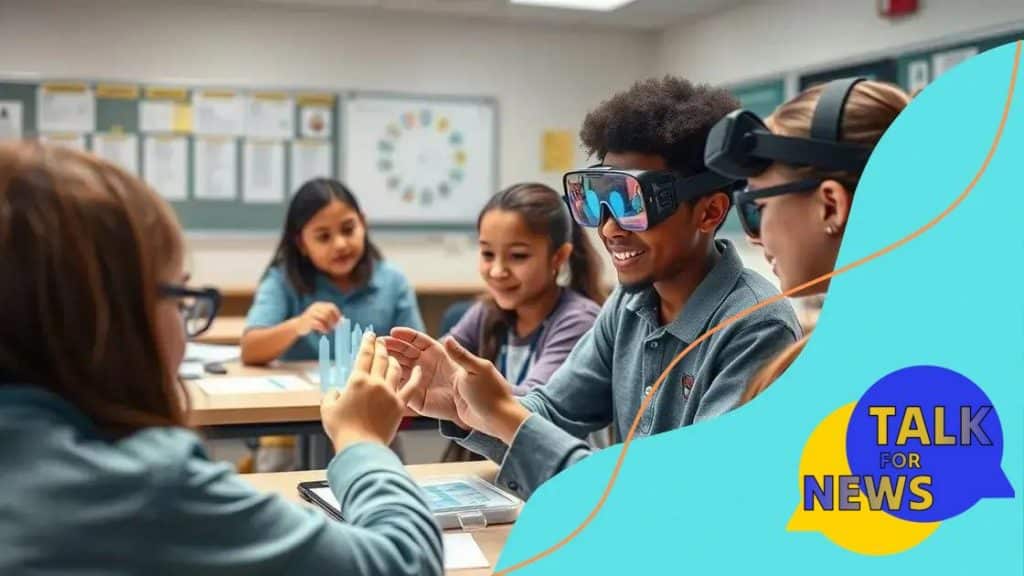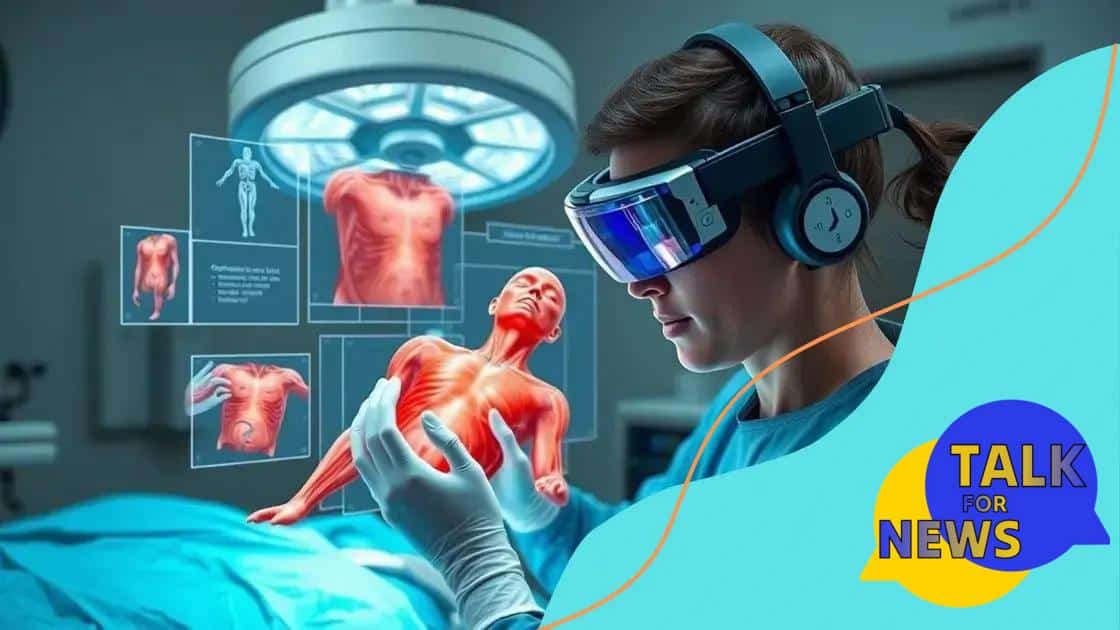How AR is being used for hands-on learning experiences

Anúncios
Augmented reality (AR) enhances education by providing interactive and personalized learning experiences, although challenges such as cost, technical issues, and the need for educator training must be addressed for successful implementation.
How AR is being used for hands-on learning experiences is an exciting trend reshaping education today. Imagine students engaging with complex subjects through interactive visuals. Curious about how this technology enhances learning?
Anúncios
Exploring the basics of augmented reality
Augmented Reality (AR) has become a key player in modern education. By blending digital elements with the real world, AR creates unique learning experiences. It allows students to visualize concepts in a way that textbooks can’t.
What is Augmented Reality?
Augmented reality enhances the real world by overlaying digital information. This can include animations, sounds, or even touch feedback. When students interact with AR, they engage multiple senses, which can improve retention and understanding of the material.
How Does AR Work?
Anúncios
AR works through devices like smartphones, tablets, or AR glasses. These devices use cameras and sensors to recognize the environment and display a digital layer over it. For example, using a smartphone camera, a student can point it at a printed page and see 3D models pop up on the screen, making learning more interactive.
Benefits of Augmented Reality
There are numerous benefits to using AR in education:
- Enhances engagement by making learning interactive.
- Helps visualize complex concepts, such as anatomy or physics.
- Encourages exploration and curiosity among students.
As educators explore the basics of augmented reality, they find that it not only captures attention but also encourages collaboration. Students can work together to solve problems, using AR to assist in brainstorming and idea generation.
Furthermore, AR allows real-time feedback. Students often learn best through hands-on experiences. With AR, they can practice skills in a safe environment before moving to real-world applications. Imagine a medical student practicing surgery on a holographic patient before touching a real one!
As we dive deeper into AR’s evolution, it becomes clear that it is a powerful educational tool. Educators are just beginning to scratch the surface of what AR can offer. By integrating this technology into curricula, they open up new avenues for teaching and learning.
Benefits of AR in educational settings
Augmented Reality (AR) brings many benefits to educational settings, transforming traditional learning into an engaging experience. Schools and universities are adopting this technology to enhance student interaction and comprehension.
Improved Engagement
One of the significant benefits of AR is improved engagement. Students are naturally drawn to technology, and AR allows them to interact with their lessons. When they can visualize data or processes in real-time, it captures their interest significantly more than standard methods.
Enhanced Understanding
AR allows for complex concepts to be broken down into easily digestible parts. For example, students studying anatomy can manipulate 3D models of organs, gaining a better understanding of their structures and functions. This hands-on experience leads to deeper learning.
Encouraging Collaboration
AR also encourages collaboration among students. When using AR tools, students can work together on projects, sharing insights and building on each other’s ideas. This teamwork fosters a sense of community and helps develop communication skills.
Accessible Learning
Another essential benefit is accessibility. AR can be tailored to meet diverse learning needs. It provides various ways to present information, catering to visual, auditory, and kinesthetic learners. Each student can learn in a way that suits them best.
- Boosts motivation through interactive learning.
- Reduces the learning gap by catering to different learning styles.
- Enhances retention by reinforcing concepts with visual aids.
By utilizing AR, educators can create immersive experiences that make learning fun and effective. The technology can adapt to different subjects, making it versatile for all educational levels. As AR continues to evolve, its applications in classrooms are only expected to grow, paving the way for future innovations in learning.
Real-world applications of AR for hands-on learning

Real-world applications of augmented reality (AR) are transforming hands-on learning experiences across various fields. This technology is not just theoretical; it is actively enhancing educational methods in schools, universities, and professional training.
Medical Training
One of the most impactful uses of AR is in medical training. Students in healthcare can use AR to simulate surgeries without risks. They can practice techniques on virtual patients, gaining confidence and skills before working with real ones. This safe approach leads to better-prepared professionals.
Engineering and Design
In engineering and design, AR allows students to visualize complex structures. They can overlay digital models on physical objects to understand how parts fit together. This capability is crucial for fields like architecture, where understanding proportions and measurements is vital.
Science Education
AR brings science experiments to life by allowing students to observe molecular structures, chemical reactions, or astronomical phenomena in three dimensions. This immersive experience helps to clarify difficult concepts and makes learning more engaging.
- Improves practical skills through realistic simulations.
- Facilitates interactive learning and student participation.
- Allows for experimentation in a controlled environment.
Additionally, AR is used in fields like history and language learning. In history classes, students can tour ancient ruins through AR applications, enhancing their understanding of cultural heritage. Language learners can practice vocabulary with AR apps that associate words with images in their environment.
As educators continue to explore the advantages of augmented reality, they find that it encourages critical thinking and problem-solving skills. Students are not just receiving information; they are applying it in real-world contexts, which enriches their learning experiences.
Challenges faced in AR implementation
Implementing augmented reality (AR) in educational settings comes with several challenges that institutions must navigate. While the benefits are clear, these obstacles can affect the effectiveness and adoption of AR technology.
Cost of Implementation
One major challenge is the cost associated with AR technology. Purchasing devices, software licenses, and training staff can require significant financial investment. Many schools and institutions may struggle to justify these expenses, especially when budgets are tight.
Technical Issues
Technical issues also present a barrier to successful AR implementation. Devices need to be compatible with AR applications, and maintaining technological infrastructure can be difficult. Schools must ensure that they have strong Wi-Fi signals and the necessary hardware to support AR experiences.
Content Creation
Creating quality educational content for AR can be time-consuming and requires specialized skills. Teachers may not have the expertise to develop AR lessons themselves, and hiring external developers can be costly. This can lead to limited resources for effective learning materials.
Resistance to Change
Many educators and administrators are often resistant to adopting new technologies. They may worry about changing their teaching methods or fear that they won’t be able to learn how to use the new tools effectively. Overcoming this resistance is crucial for the successful integration of AR.
Training and Support
Even when AR technology is implemented, providing ongoing training and support for teachers is essential. Educators need to feel confident in using AR tools in the classroom. Without proper training, the potential of AR technology may not be fully realized.
- Understanding different learning styles can help tailor AR experiences.
- Engaging stakeholders early in the process can ease resistance.
- Investing in professional development can improve technology adoption.
Despite these challenges, many institutions are exploring AR as a way to enhance learning outcomes. By addressing these obstacles, schools can better integrate AR technology and provide students with engaging, hands-on learning experiences.
Future trends in AR for education
The future of augmented reality (AR) in education looks promising and full of potential. As technology advances, AR is expected to become an essential tool in improving learning experiences. Schools and institutions will continue to integrate AR into their curricula, providing innovative ways for students to engage with material.
Personalized Learning Experiences
One significant trend is the move towards personalized learning experiences. AR can adapt to the needs of individual students, allowing them to learn at their own pace. This tailored approach can help students grasp difficult concepts more effectively.
Integration with AI and VR
Another trend is the integration of AR with artificial intelligence (AI) and virtual reality (VR). Combining these technologies will create more immersive educational environments. Students can explore virtual worlds while also receiving real-time feedback from AI systems, enhancing their learning journey.
Accessibility and Inclusivity
The push for inclusivity is also shaping the future of AR in education. Developers are focusing on creating AR applications that cater to diverse learning needs. This means making resources available for students with disabilities, ensuring they can benefit from innovative learning methods.
Enhanced Collaboration
Future trends will likely emphasize enhanced collaboration among students. AR enables more interactive group work, where students can collaborate on projects in real-time, regardless of their physical locations. This approach not only fosters teamwork but also helps students learn from one another.
- Using gamification to motivate students through AR experiences.
- Expanding AR content libraries so educators have access to a wider range of teaching materials.
- Incorporating AR into standardized testing to create more dynamic assessments.
As these trends emerge, educational institutions will need to invest in training educators to use AR tools effectively. Embracing these innovations will be crucial for fostering a new generation of learners who are equipped with the skills needed for the future. Ultimately, the continued evolution of AR presents exciting opportunities for reshaping the educational landscape.
FAQ – Frequently Asked Questions about Augmented Reality in Education
What are the main benefits of using AR in education?
Using AR in education enhances engagement, improves understanding of complex concepts, and promotes interactive learning experiences.
What challenges do schools face when implementing AR technology?
Schools may struggle with costs, technical issues, and the need for training teachers to effectively use AR tools.
How does AR personalize learning for students?
AR provides customized experiences by allowing students to learn at their own pace and in their preferred learning styles.
What future trends can we expect in AR for education?
Future trends include integration with AI, increased accessibility, and more collaborative learning environments.





